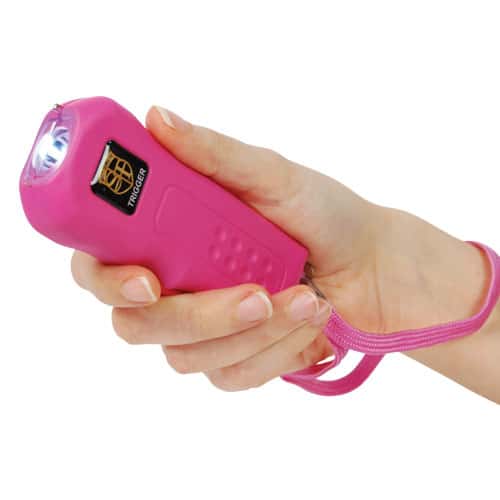Stun Guns And Tasers Aren’t The Same
Are stun guns and tasers the same? No, stun guns and TASERs aren’t the same. You need to understand this important distinction to empower yourself in self-defense. A stun gun requires you to make direct contact with an attacker, administering an electric shock that causes pain and muscle contractions. On the flip side, TASERs offer you a safer distance option, launching probes that can incapacitate a threat from up to 15 feet away, inducing neuromuscular incapacitation.
Both of these weapons are effective, but your choice depends on how close you’re willing to get. Make sure you know the laws in your area, and remember, knowledge is your first line of defense. Gain more insights to stay equipped and confident.
Key Takeaways
- Stun guns require direct contact to deliver an electric shock, unlike TASERs.
- TASERs can incapacitate from a distance, using probes that attach to the target.
- Stun guns cause pain and muscle contractions; TASERs induce neuromuscular incapacitation.
- TASER devices can operate effectively up to 35 feet away, providing safer distance defense.
- While both devices offer self-defense capabilities, their operational methods and range differ significantly.
Defining Stun Guns and Tasers
Understanding the distinction between stun guns and Tasers is vital, as they offer different methods of self-defense. When you’re considering your safety options, knowing what sets these tools apart isn’t just wise—it’s indispensable.
A stun gun requires you to be up close and personal, making direct contact to deliver an electric shock. This shock causes pain and muscle contractions, momentarily disorienting an attacker and giving you a chance to escape. It’s a hands-on approach to protection, literally.
On the other hand, a TASER allows you to maintain distance between yourself and a threat. It launches projectile probes that can reach an assailant from afar, delivering an electric shock that results in neuromuscular incapacitation. This means it disrupts the communication between the brain and muscles, temporarily disabling the target without relying on pain alone. It’s a more advanced option for those looking for a way to stay safe from a distance.
Both stun guns and TASERs offer a layer of security, but understanding the unique capabilities of each—stun guns with their immediate muscle contractions and TASERs with their neuromuscular incapacitation—can empower you to choose the right self-defense tool for your needs.
Key Operational Differences
When choosing between a stun gun and a taser for self-defense, it’s critical to know their key operational differences. Here’s what you need to understand:
- Method of Application:
- Stun guns require you to be up close and personal, needing direct contact to be effective.
- Tasers give you the advantage of distance, launching probes to incapacitate an attacker from afar.
- Effect on Target:
- The moment a stun gun makes contact, it delivers intense pain and muscle contractions.
- Tasers go a step further by inducing neuromuscular incapacitation. This means they disrupt the communication between the muscles and the brain, causing the attacker to lose control and fall over, offering a higher level of incapacitation.
- Incidence of Contact:
- With stun guns, you’ve got to make physical contact to deliver the shock.
- Tasers allow for incapacitation without needing to touch the attacker, thanks to their barbs that can be fired out.
Understanding these operational differences between stun guns and tasers isn’t just about making an informed choice; it’s about equipping yourself with the right tool for your safety. Knowing how each device works will empower you to use them effectively in self-defense situations.
Range and Accessibility
One of the most significant differences between stun guns and TASER devices lies in their range and accessibility, with TASERs offering the ability to incapacitate threats from up to 35 feet away. This means you’re not waiting for danger to come within arm’s reach before you can protect yourself. Instead, you’ve got the upper hand from a distance, which can be a game-changer in a self-defense situation.
| Feature | Stun Guns | TASER Devices |
|---|---|---|
| Range | Direct contact required | Up to 35 feet |
| Proximity | Close proximity to threat necessary | Can keep distance from attackers |
| Incapacitation | Direct muscle contact | Neuromuscular incapacitation |
| Accessibility | Limited range | Increased accessibility and safety |
With TASER devices, you’re not just thinking about self-defense; you’re considering how to maximize your safety through distance and incapacitation. Their ability to shut down muscle functions from afar means you can keep yourself safe without getting too close for comfort. On the other hand, stun guns, while effective, require you to be within touching distance to disable a threat. It’s clear that when it comes to range, distance, and accessibility, TASERs offer a significant advantage for self-defense.
Safety and Legal Considerations
Familiarizing yourself with the specific safety mechanisms and legal regulations surrounding stun guns and Tasers before carrying or using them is essential. Understanding these devices enhances your personal safety and guarantees you’re in compliance with the law.
Stun guns and Tasers, although both designed for self-defense, have notable differences in operation and safety features. Stun guns require you to be in close proximity to an assailant to deliver an electrical charge directly, while Tasers can be deployed from a distance, offering a safer gap between you and a potential threat.
Here are three key points to remember:
- Legal Regulations: Always check your local laws regarding the possession and use of stun guns and Tasers. Restrictions vary widely, and what’s permissible in one area might be illegal in another.
- Safety Mechanisms: Both devices come equipped with safety features to prevent accidental discharge. Familiarize yourself with these mechanisms to ensure you can use the device effectively and safely.
- Training and Knowledge: Proper training from law enforcement agencies or certified instructors is essential. Understanding the differences between stun guns and Tasers, including how to operate them safely, can make all the difference in a critical situation.
Making the Right Choice

Understanding the key differences between stun guns and Tasers is crucial for selecting the most suitable self-defense tool for your needs. When you’re weighing your options for personal defense, it’s vital to grasp the unique capabilities of each. The 75 million volt Trigger stun gun, sold at nittanyselfdefense.com, is pictured above.
Stun Gun vs. TASER gun debates often boil down to their operational differences. Stun guns require you to be up close and personal, ideal for those who prefer a compact size that easily fits into a purse or pocket. On the other hand, TASER guns, favored by law enforcement personnel, offer the advantage of incapacitating an assailant from a distance of up to 15 feet, providing a safer space between you and the threat.
Making the right choice for your personal protection involves considering how comfortable you’re with the device’s range and method of incapacitation. If your priority is stopping a potential attacker without getting too close, a TASER might be your best bet. However, if you’re looking for a more budget-friendly option that still packs a punch, a stun gun could be the way to go.
To learn more about the differences between stun guns and tasers, watch this helpful video.
Frequently Asked Questions
Which Is Stronger a Taser or Stun Gun?
You’re wondering which packs a bigger punch, a taser or stun gun. Tasers are stronger, offering more voltage and causing neuromuscular incapacitation. They’re safer, with a quicker recovery time, widely available, and useful in various scenarios.
Is It Legal to Carry Around a Stun Gun?
You can legally carry a stun gun in many states for self-defense, but check local laws for carry permits, age restrictions, and concealment rules. Public safety concerns dictate usage scenarios and places where it’s prohibited.
Are Stun Guns Legal in Or?
Yes, stun guns are legal in Oregon. You’ll need to follow state regulations, understand local laws, review purchase options, check age restrictions, and possibly undergo safety training for personal defense. Always stay informed and cautious.
What Is the Difference Between a Civilian Taser and a Police Taser?
Civilian and police Taser models differ in range, with police Tasers reaching farther. Police versions often have advanced safety features, usage training, and recertification requirements, while civilian models focus on personal defense with simpler deployment methods.


